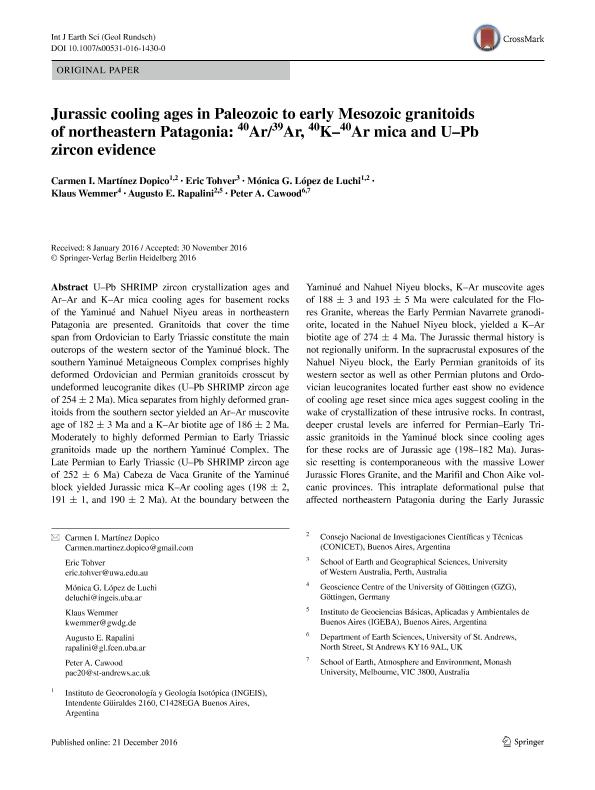Mostrar el registro sencillo del ítem
dc.contributor.author
Martínez Dopico, Carmen Irene

dc.contributor.author
Tohver, Eric
dc.contributor.author
Lopez, Monica Graciela

dc.contributor.author
Wemmer, Klaus

dc.contributor.author
Rapalini, Augusto Ernesto

dc.contributor.author
Cawood, Peter A.
dc.date.available
2018-04-26T14:33:37Z
dc.date.issued
2016-12
dc.identifier.citation
Martínez Dopico, Carmen Irene; Tohver, Eric; Lopez, Monica Graciela; Wemmer, Klaus; Rapalini, Augusto Ernesto; et al.; Jurassic cooling ages in Paleozoic to early Mesozoic granitoids of northeastern Patagonia: 40Ar/39Ar, 40K–40Ar mica and U–Pb zircon evidence; Springer; International Journal of Earth Sciences; 106; 7; 12-2016; 2343-2357
dc.identifier.issn
1437-3254
dc.identifier.uri
http://hdl.handle.net/11336/43530
dc.description.abstract
U–Pb SHRIMP zircon crystallization ages and Ar–Ar and K–Ar mica cooling ages for basement rocks of the Yaminué and Nahuel Niyeu areas in northeastern Patagonia are presented. Granitoids that cover the time span from Ordovician to Early Triassic constitute the main outcrops of the western sector of the Yaminué block. The southern Yaminué Metaigneous Complex comprises highly deformed Ordovician and Permian granitoids crosscut by undeformed leucogranite dikes (U–Pb SHRIMP zircon age of 254 ± 2 Ma). Mica separates from highly deformed granitoids from the southern sector yielded an Ar–Ar muscovite age of 182 ± 3 Ma and a K–Ar biotite age of 186 ± 2 Ma. Moderately to highly deformed Permian to Early Triassic granitoids made up the northern Yaminué Complex. The Late Permian to Early Triassic (U–Pb SHRIMP zircon age of 252 ± 6 Ma) Cabeza de Vaca Granite of the Yaminué block yielded Jurassic mica K–Ar cooling ages (198 ± 2, 191 ± 1, and 190 ± 2 Ma). At the boundary between the Yaminué and Nahuel Niyeu blocks, K–Ar muscovite ages of 188 ± 3 and 193 ± 5 Ma were calculated for the Flores Granite, whereas the Early Permian Navarrete granodiorite, located in the Nahuel Niyeu block, yielded a K–Ar biotite age of 274 ± 4 Ma. The Jurassic thermal history is not regionally uniform. In the supracrustal exposures of the Nahuel Niyeu block, the Early Permian granitoids of its western sector as well as other Permian plutons and Ordovician leucogranites located further east show no evidence of cooling age reset since mica ages suggest cooling in the wake of crystallization of these intrusive rocks. In contrast, deeper crustal levels are inferred for Permian–Early Triassic granitoids in the Yaminué block since cooling ages for these rocks are of Jurassic age (198–182 Ma). Jurassic resetting is contemporaneous with the massive Lower Jurassic Flores Granite, and the Marifil and Chon Aike volcanic provinces. This intraplate deformational pulse that affected northeastern Patagonia during the Early Jurassic (Sinemurian–Pliensbachian) was responsible for the partial (re)exhumation of the mid-crustal Paleozoic basement along reactivated discrete NE–SW to ENE–WSW lineaments and the resetting of isotopic systems. These new thermochronological data indicate that Early Permian magmatic rocks of the Nahuel Niyeu block were below 300 °C for ca. 20 Ma prior to the onset of the main magmatic episode of the Late Permian to Triassic igneous and metaigneous rocks of the Yaminué block.
dc.format
application/pdf
dc.language.iso
eng
dc.publisher
Springer

dc.rights
info:eu-repo/semantics/openAccess
dc.rights.uri
https://creativecommons.org/licenses/by-nc-sa/2.5/ar/
dc.subject
Patagonia
dc.subject
Magmatism
dc.subject
Paleozoic Basement
dc.subject
Reset Crystallization Ages
dc.subject
Cooling Ages
dc.subject.classification
Meteorología y Ciencias Atmosféricas

dc.subject.classification
Ciencias de la Tierra y relacionadas con el Medio Ambiente

dc.subject.classification
CIENCIAS NATURALES Y EXACTAS

dc.title
Jurassic cooling ages in Paleozoic to early Mesozoic granitoids of northeastern Patagonia: 40Ar/39Ar, 40K–40Ar mica and U–Pb zircon evidence
dc.type
info:eu-repo/semantics/article
dc.type
info:ar-repo/semantics/artículo
dc.type
info:eu-repo/semantics/publishedVersion
dc.date.updated
2018-04-13T20:01:44Z
dc.identifier.eissn
1437-3262
dc.journal.volume
106
dc.journal.number
7
dc.journal.pagination
2343-2357
dc.journal.pais
Alemania

dc.journal.ciudad
Berlín
dc.description.fil
Fil: Martínez Dopico, Carmen Irene. Consejo Nacional de Investigaciones Científicas y Técnicas. Oficina de Coordinación Administrativa Ciudad Universitaria. Instituto de Geocronología y Geología Isotopica. Universidad de Buenos Aires. Facultad de Ciencias Exactas y Naturales. Instituto de Geocronología y Geología Isotópica; Argentina
dc.description.fil
Fil: Tohver, Eric. University of Western Australia. School of Earth and Geographical Sciences; Australia
dc.description.fil
Fil: Lopez, Monica Graciela. Consejo Nacional de Investigaciones Científicas y Técnicas. Oficina de Coordinación Administrativa Ciudad Universitaria. Instituto de Geocronología y Geología Isotopica. Universidad de Buenos Aires. Facultad de Ciencias Exactas y Naturales. Instituto de Geocronología y Geología Isotópica; Argentina
dc.description.fil
Fil: Wemmer, Klaus. Universität Göttingen; Alemania
dc.description.fil
Fil: Rapalini, Augusto Ernesto. Consejo Nacional de Investigaciones Científicas y Técnicas. Oficina de Coordinación Administrativa Ciudad Universitaria. Instituto de Geociencias Básicas, Aplicadas y Ambientales de Buenos Aires. Universidad de Buenos Aires. Facultad de Ciencias Exactas y Naturales. Instituto de Geociencias Básicas, Aplicadas y Ambientales de Buenos Aires; Argentina
dc.description.fil
Fil: Cawood, Peter A.. Monash University; Australia. University of St. Andrews; Reino Unido
dc.journal.title
International Journal of Earth Sciences

dc.relation.alternativeid
info:eu-repo/semantics/altIdentifier/doi/https://doi.org/10.1007/s00531-016-1430-0
dc.relation.alternativeid
info:eu-repo/semantics/altIdentifier/url/https://link.springer.com/article/10.1007%2Fs00531-016-1430-0
Archivos asociados
